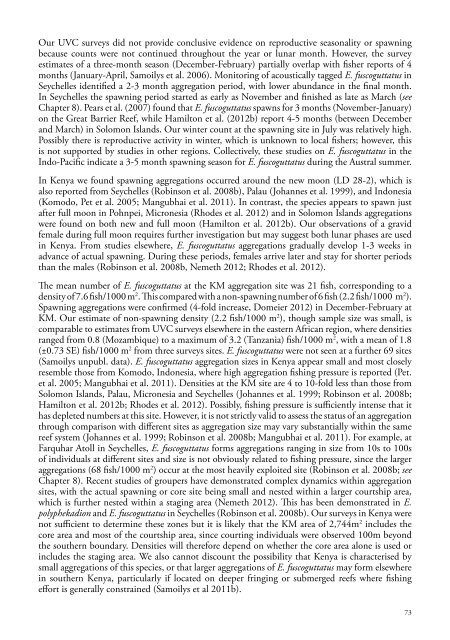WIOMSA-CORDIO spawning book Full Doc 10 oct 13.pdf
WIOMSA-CORDIO spawning book Full Doc 10 oct 13.pdf
WIOMSA-CORDIO spawning book Full Doc 10 oct 13.pdf
Create successful ePaper yourself
Turn your PDF publications into a flip-book with our unique Google optimized e-Paper software.
Our UVC surveys did not provide conclusive evidence on reproductive seasonality or <strong>spawning</strong>because counts were not continued throughout the year or lunar month. However, the surveyestimates of a three-month season (December-February) partially overlap with fisher reports of 4months (January-April, Samoilys et al. 2006). Monitoring of acoustically tagged E. fuscoguttatus inSeychelles identified a 2-3 month aggregation period, with lower abundance in the final month.In Seychelles the <strong>spawning</strong> period started as early as November and finished as late as March (seeChapter 8). Pears et al. (2007) found that E. fuscoguttatus spawns for 3 months (November-January)on the Great Barrier Reef, while Hamilton et al. (2012b) report 4-5 months (between Decemberand March) in Solomon Islands. Our winter count at the <strong>spawning</strong> site in July was relatively high.Possibly there is reproductive activity in winter, which is unknown to local fishers; however, thisis not supported by studies in other regions. Collectively, these studies on E. fuscoguttatus in theIndo-Pacific indicate a 3-5 month <strong>spawning</strong> season for E. fuscoguttatus during the Austral summer.In Kenya we found <strong>spawning</strong> aggregations occurred around the new moon (LD 28-2), which isalso reported from Seychelles (Robinson et al. 2008b), Palau (Johannes et al. 1999), and Indonesia(Komodo, Pet et al. 2005; Mangubhai et al. 2011). In contrast, the species appears to spawn justafter full moon in Pohnpei, Micronesia (Rhodes et al. 2012) and in Solomon Islands aggregationswere found on both new and full moon (Hamilton et al. 2012b). Our observations of a gravidfemale during full moon requires further investigation but may suggest both lunar phases are usedin Kenya. From studies elsewhere, E. fuscoguttatus aggregations gradually develop 1-3 weeks inadvance of actual <strong>spawning</strong>. During these periods, females arrive later and stay for shorter periodsthan the males (Robinson et al. 2008b, Nemeth 2012; Rhodes et al. 2012).The mean number of E. fuscoguttatus at the KM aggregation site was 21 fish, corresponding to adensity of 7.6 fish/<strong>10</strong>00 m 2 . This compared with a non-<strong>spawning</strong> number of 6 fish (2.2 fish/<strong>10</strong>00 m 2 ).Spawning aggregations were confirmed (4-fold increase, Domeier 2012) in December-February atKM. Our estimate of non-<strong>spawning</strong> density (2.2 fish/<strong>10</strong>00 m 2 ), though sample size was small, iscomparable to estimates from UVC surveys elsewhere in the eastern African region, where densitiesranged from 0.8 (Mozambique) to a maximum of 3.2 (Tanzania) fish/<strong>10</strong>00 m 2 , with a mean of 1.8(±0.73 SE) fish/<strong>10</strong>00 m 2 from three surveys sites. E. fuscoguttatus were not seen at a further 69 sites(Samoilys unpubl. data). E. fuscoguttatus aggregation sizes in Kenya appear small and most closelyresemble those from Komodo, Indonesia, where high aggregation fishing pressure is reported (Pet.et al. 2005; Mangubhai et al. 2011). Densities at the KM site are 4 to <strong>10</strong>-fold less than those fromSolomon Islands, Palau, Micronesia and Seychelles (Johannes et al. 1999; Robinson et al. 2008b;Hamilton et al. 2012b; Rhodes et al. 2012). Possibly, fishing pressure is sufficiently intense that ithas depleted numbers at this site. However, it is not strictly valid to assess the status of an aggregationthrough comparison with different sites as aggregation size may vary substantially within the samereef system (Johannes et al. 1999; Robinson et al. 2008b; Mangubhai et al. 2011). For example, atFarquhar Atoll in Seychelles, E. fuscoguttatus forms aggregations ranging in size from <strong>10</strong>s to <strong>10</strong>0sof individuals at different sites and size is not obviously related to fishing pressure, since the largeraggregations (68 fish/<strong>10</strong>00 m 2 ) occur at the most heavily exploited site (Robinson et al. 2008b; seeChapter 8). Recent studies of groupers have demonstrated complex dynamics within aggregationsites, with the actual <strong>spawning</strong> or core site being small and nested within a larger courtship area,which is further nested within a staging area (Nemeth 2012). This has been demonstrated in E.polyphekadion and E. fuscoguttatus in Seychelles (Robinson et al. 2008b). Our surveys in Kenya werenot sufficient to determine these zones but it is likely that the KM area of 2,744m 2 includes thecore area and most of the courtship area, since courting individuals were observed <strong>10</strong>0m beyondthe southern boundary. Densities will therefore depend on whether the core area alone is used orincludes the staging area. We also cannot discount the possibility that Kenya is characterised bysmall aggregations of this species, or that larger aggregations of E. fuscoguttatus may form elsewherein southern Kenya, particularly if located on deeper fringing or submerged reefs where fishingeffort is generally constrained (Samoilys et al 2011b).73


















